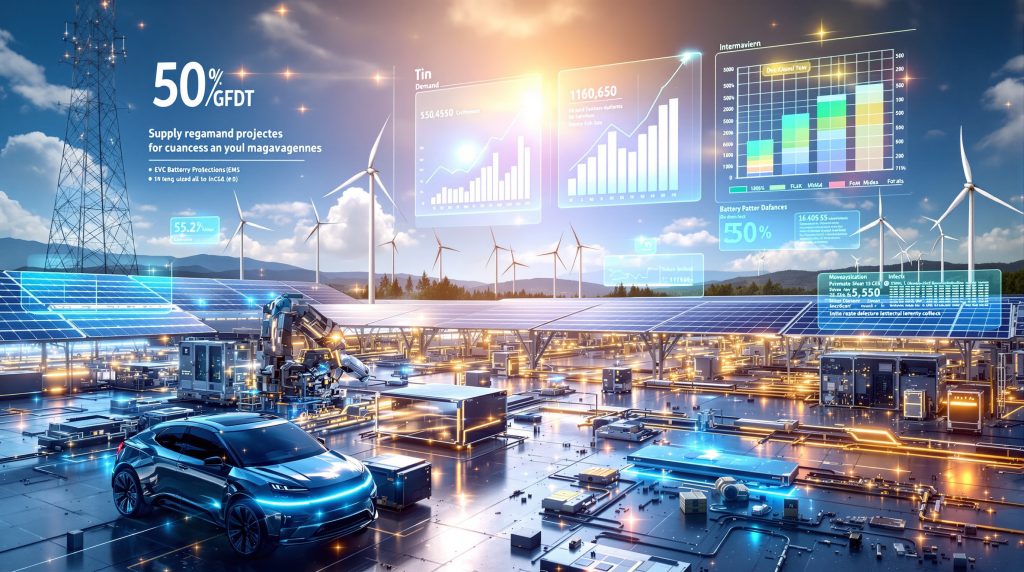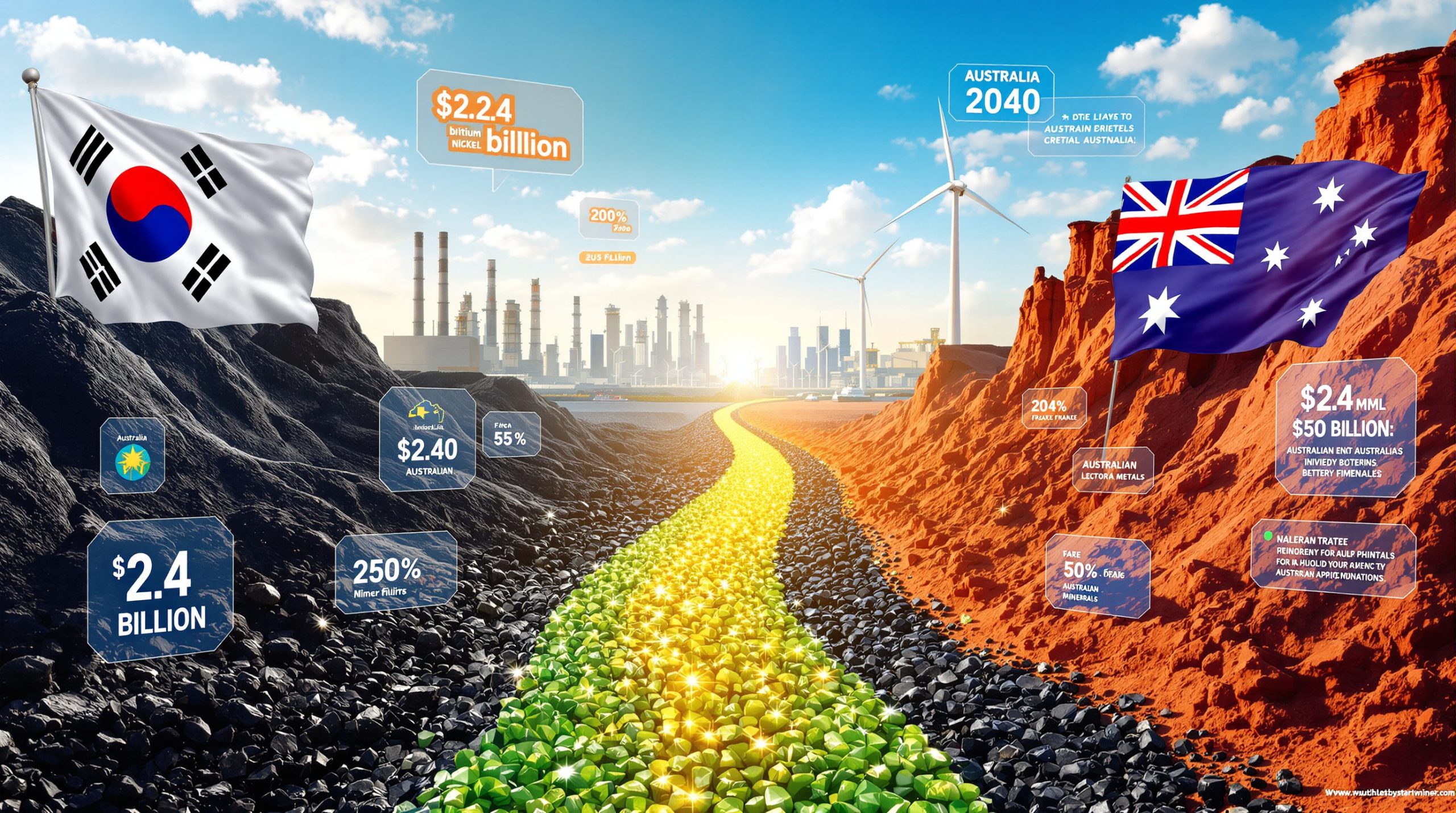The Critical Mineral Positioning Framework
The global energy infrastructure transformation creates unprecedented demand for specialized materials that enable renewable systems, electric vehicles, and digital networks. Among these enabling materials, certain metals exhibit properties that make them irreplaceable across multiple clean energy applications while facing constrained supply pipelines and geopolitical concentration risks.
This analysis examines strategic positioning frameworks for materials that serve as infrastructure components rather than energy storage elements. Unlike lithium or cobalt, which primarily function within battery chemistries, these enabling materials create the fundamental connections and protective systems that allow clean energy technologies to operate reliably across decades-long operational lifecycles.
Atomic Structure Creates Irreplaceable Clean Energy Applications
Tin's strategic value in clean energy transition stems from its unique atomic configuration with 50 protons that creates specific metallurgical properties essential for renewable energy electronics. The metal's crystalline structure enables formation of reliable solder joints that maintain electrical conductivity under thermal cycling conditions typical in solar inverters, wind turbine electronics, and electric vehicle power systems.
Modern renewable energy installations require thousands of individual electrical connections per megawatt of capacity. Each photovoltaic panel contains approximately 1,000-1,500 solder joints connecting solar cells to electrical circuits. These connections must withstand temperature variations from -40°C to +85°C over 25-year operational periods while maintaining consistent electrical resistance.
Critical Properties Enabling Clean Energy Applications:
- Thermal stability: Maintains mechanical integrity across temperature ranges
- Corrosion resistance: Provides long-term reliability in outdoor installations
- Electrical conductivity: Enables efficient power transfer with minimal losses
- Workability: Allows precise application in miniaturised electronics
The transition from lead-based to tin-based solder systems, mandated by the European Union's Restriction of Hazardous Substances Directive, created structural demand growth as electronics manufacturers globally adopted tin-silver-copper alloy systems. This regulatory shift established tin as the standard for all new electronics manufacturing serving renewable energy markets.
Advanced Semiconductor Requirements Drive Precision Demand
Next-generation power electronics require solder systems capable of atomic-level precision in chip-scale packaging applications. Advanced inverters for solar installations and electric vehicle powertrains utilise wide-bandgap semiconductors that operate at higher temperatures and switching frequencies than traditional silicon devices.
These advanced semiconductor packages demand solder alloys with specific thermal expansion coefficients that match silicon carbide and gallium nitride substrates. Tin-silver-copper formulations provide the precise thermal expansion matching required to prevent mechanical failure during thermal cycling in high-performance applications.
Furthermore, as highlighted by Wood Mackenzie's analysis, the role of tin in the energy transition has been significantly undervalued despite its critical applications.
According to industry projections, each megawatt of renewable energy infrastructure requires approximately 15-20 kilograms of specialised solder materials across inverters, monitoring systems, and grid interconnection hardware.
Multiple Demand Growth Scenarios Through 2035
Scenario modelling for tin consumption reflects different pathways for global electrification and technology deployment. These scenarios incorporate electric vehicle adoption rates, renewable energy capacity growth, and data centre expansion driven by artificial intelligence applications.
Accelerated Transition Scenario:
- Electric vehicle market share reaches 70% of new sales by 2030
- Solar photovoltaic capacity grows 300% from 2024 baseline
- Data centre computing power increases 250% supporting renewable grid management
- Projected annual tin consumption: 580,000 tonnes by 2035
Baseline Development Scenario:
- Electric vehicle adoption reaches 50% of new vehicle sales by 2030
- Solar capacity doubles from current installed base
- Steady electronics manufacturing growth
- Projected annual tin consumption: 480,000 tonnes by 2035
Conservative Transition Scenario:
- Electric vehicle adoption limited to 35% by infrastructure constraints
- Renewable energy deployment constrained by grid integration challenges
- Projected annual tin consumption: 420,000 tonnes by 2035
Current global tin production operates near 350,000 tonnes annually, indicating potential supply deficits across all scenarios unless new primary production comes online. The International Tin Association projects demand growth of up to 40 percent by 2030, primarily driven by electrification and semiconductor applications.
Supply Response Constraints Create Strategic Bottlenecks
New tin mining projects require 7-12 years from discovery to commercial production, creating structural inflexibility in supply response to demand growth. Unlike industrial materials with multiple production pathways, primary tin extraction depends on specific geological formations that limit potential supply sources.
Global Tin Production Analysis:
| Region | Annual Production | Development Potential | Supply Security |
|---|---|---|---|
| China | 95,000 tonnes | Limited expansion | Domestic priority |
| Indonesia | 72,000 tonnes | Moderate growth | Export restrictions |
| Myanmar | 48,000 tonnes | Declining output | Political instability |
| Peru | 19,000 tonnes | High potential | Stable jurisdiction |
| Bolivia | 18,000 tonnes | Expansion possible | Resource nationalism |
Indonesia's position as the second-largest producer creates particular supply chain vulnerability. The country has implemented export licensing requirements and local processing mandates that constrain tin availability for international markets. These policies reflect broader trends toward resource nationalism that prioritise domestic value-added processing over raw material exports.
Geographic Concentration Amplifies Supply Vulnerabilities
Approximately 65% of global tin production originates from Southeast Asia, where political instability, regulatory changes, and infrastructure limitations create recurring supply disruptions. Myanmar's contribution of approximately 48,000 tonnes annually faces ongoing challenges from civil conflict and international sanctions.
This geographic concentration creates systemic risks similar to rare earth element dependencies that prompted strategic stockpiling initiatives in the United States and European Union. However, establishing Europe's CRM hub represents a crucial step toward supply chain diversification.
Strategic Stockpiling Initiatives Address Critical Dependencies
The United States consumes approximately 32,000 tonnes of tin annually while producing zero primary tin domestically. This complete import dependence mirrors vulnerabilities identified in rare earth elements, lithium, and other critical minerals supply chain dependencies essential for national security applications.
Government strategic reserves serve multiple functions beyond supply security. Reserve purchases provide price stability during demand surges whilst creating strategic optionality for supply chain disruptions. The U.S. Defense Production Act authorises federal investment in domestic processing capabilities and alternative supply development.
Critical Supply Chokepoints:
- Indonesian export licensing and processing requirements
- Myanmar political instability affecting 14% of global supply
- Limited smelting capacity outside Asia-Pacific region
- Transportation bottlenecks through Southeast Asian ports
European Union policy frameworks include tin among critical raw materials subject to supply diversification mandates. The Critical Raw Materials Act establishes targets for reducing import dependencies and developing domestic processing capabilities for materials deemed essential for clean energy transition.
Technology Evolution Creates Expanding Applications
Renewable energy infrastructure expansion requires tin-based electronics across multiple system components. Solar photovoltaic installations utilise tin solder for electrical connections between cells, junction boxes, combiner circuits, and power conditioning equipment.
Wind energy systems incorporate tin solder in generator electronics, power conversion equipment, and control systems. Each wind turbine contains approximately 1-2 tonnes of electronics requiring specialised solder materials designed for vibration resistance and long-term reliability.
Technology Trend Analysis:
- Bifacial solar panels: Increase tin consumption by 30% per installation
- Floating solar systems: Require enhanced corrosion protection
- Advanced inverter technologies: Demand higher-performance solder systems
- Grid-scale energy storage: Creates new tin application categories
Electric Vehicle Electronics Complexity Scaling
Modern electric vehicles contain 4-6 times more electronic components than internal combustion vehicles. Battery management systems, power electronics, charging infrastructure, and autonomous driving sensors create dense networks of tin-soldered connections throughout vehicle electrical systems.
In addition to transportation applications, understanding the broader context of energy transition minerals helps illustrate tin's strategic positioning within the clean energy ecosystem.
Per-Vehicle Tin Content Analysis:
- Battery management and safety systems: 0.9-1.3 kg per vehicle
- Power electronics and motor controllers: 1.2-1.8 kg per vehicle
- Charging and connectivity systems: 0.5-0.7 kg per vehicle
- Autonomous driving electronics: 0.4-1.2 kg per vehicle (emerging)
Electric vehicle charging infrastructure represents an additional demand category requiring tin-based electronics for power conversion, grid interconnection, and communication systems. Each fast-charging station contains approximately 15-25 kg of electronics requiring specialised solder materials.
Investment Framework Development for Critical Materials Exposure
Traditional commodity valuation models inadequately capture tin's strategic value in clean energy transition beyond standard supply-demand fundamentals. Alternative analytical frameworks must incorporate supply security premiums, substitution constraints, and technology adoption multipliers.
Strategic Valuation Components:
- Base commodity fundamentals: Current market price and demand volumes
- Supply security premium: 20-30% markup reflecting geopolitical concentration
- Technology adoption multiplier: 1.3-2.1x based on electrification deployment pace
- Strategic reserve demand: Additional 5-10% from government stockpiling
Portfolio construction for tin exposure requires indirect approaches through mining equities, integrated materials companies, and technology manufacturers. Direct tin investment vehicles remain limited compared to precious metals or energy commodities.
Risk-Return Modelling Across Investment Vehicles
Monte Carlo simulations incorporating demand scenarios, supply disruptions, and price volatility suggest tin-exposed investments could outperform broader commodity indices by 180-350 basis points annually through 2030, though with higher volatility profiles.
Investment Exposure Options:
- Primary tin producers: Direct exposure with operational risk concentration
- Diversified miners: Tin revenue components within broader metal portfolios
- Electronics manufacturers: Indirect exposure through tin-intensive product lines
- Strategic material funds: Emerging vehicles focusing on critical mineral exposure
Risk-adjusted return optimisation requires balancing direct commodity exposure against operational risks in tin-producing regions. Companies with established operations in stable jurisdictions command valuation premiums despite potentially lower tin grades or production volumes.
Corporate Strategy Development for Supply Chain Resilience
Technology companies dependent on tin-intensive manufacturing should develop comprehensive procurement strategies incorporating price hedging, supplier diversification, and strategic inventory optimisation. Supply chain resilience has become a competitive advantage as critical material availability constraints affect production scheduling.
Moreover, companies must align their procurement strategies with evolving critical minerals strategy frameworks at the national level to ensure long-term supply security.
Strategic Procurement Framework Elements:
- Multi-year demand forecasting: Integrating technology roadmaps with material requirements
- Geographic supplier assessment: Evaluating political and operational risks
- Inventory optimisation: Balancing carrying costs against supply security
- Alternative material research: Long-term substitution development programmes
Research and development investments should prioritise tin-efficient technologies that maintain performance whilst reducing material intensity. Companies achieving superior tin utilisation efficiency gain competitive advantages as supply constraints tighten.
Policy Coordination Requirements for International Cooperation
Effective critical material security requires coordination between consuming nations, producing countries, and multilateral organisations. Policy frameworks must address mining investment incentives, recycling infrastructure development, and strategic reserve coordination.
The United States, European Union, Japan, and Australia have established coordination mechanisms for critical material supply chain resilience. These frameworks include information sharing on production capacity, joint strategic reserve management, and coordinated responses to supply disruptions.
International cooperation initiatives focus on supporting responsible mining development in emerging jurisdictions whilst building domestic processing capabilities in consuming countries. Furthermore, considering the insights from CRUX Investor's analysis, technology transfer programmes and development finance mechanisms aim to diversify supply sources beyond current geographic concentrations.
Defence Applications Heighten Strategic Importance
Military applications of tin extend beyond commercial electronics to encompass specialised defence systems requiring extreme reliability under harsh operational conditions. Advanced radar systems, military communications equipment, and precision weaponry depend on tin-based solder joints that maintain functionality across temperature extremes and electromagnetic interference.
The development of a comprehensive defence minerals strategy recognises tin's dual-use nature and the need for secure supply chains to support both civilian infrastructure and military applications.
Defence-Critical Tin Applications:
- Military communications: Secure radio and satellite systems
- Avionics electronics: Aircraft navigation and control systems
- Naval systems: Shipboard electronics and sonar equipment
- Land-based defence: Radar installations and command centres
This dual-use characteristic elevates tin's strategic value in clean energy transition beyond commercial considerations to encompass national security implications that justify government intervention in supply chain development.
Strategic Positioning for Material-Enabled Energy Transition
Tin's strategic importance extends beyond traditional commodity market dynamics to encompass national security considerations, technological sovereignty, and industrial competitiveness factors. The material's irreplaceable role in electronics manufacturing positions it as critical infrastructure for renewable energy systems, electric vehicles, and digital networks supporting decarbonisation.
Strategic scenario modelling indicates potential supply tightness emerging by 2027-2028 under baseline electrification scenarios, with more severe constraints possible by 2030-2031 if technology deployment accelerates beyond current projections. Geographic supply concentration in politically unstable regions amplifies these risks whilst limited substitution options constrain demand elasticity.
Investment approaches must recognise tin's strategic value in clean energy transition beyond traditional commodity fundamentals, incorporating the material's role as enabling infrastructure for clean energy transition. Corporate strategic planning should prioritise supply chain diversification and efficiency improvements, whilst policy frameworks require international coordination on critical material security.
The convergence of electrification trends, supply constraints, and geopolitical factors positions tin among the most strategically significant materials for the next decade of energy infrastructure development. Organisations that develop comprehensive strategies for tin's strategic value in clean energy transition exposure and supply security will be better positioned to capitalise on clean energy transition opportunities whilst managing material availability risks.
This analysis reflects current market conditions and technological trends. Commodity markets involve substantial risks, and material demand projections contain inherent uncertainties. Investors should conduct independent research and consider professional advisory services before making investment decisions.
Ready to Position Yourself Ahead of the Next Critical Mineral Discovery?
Discovery Alert's proprietary Discovery IQ model delivers instant notifications on significant ASX mineral discoveries, including critical materials like tin that are essential for clean energy infrastructure. Experience why major discoveries can generate exceptional returns by exploring Discovery Alert's discoveries page and begin your 30-day free trial today to secure your competitive advantage in the critical minerals market.




